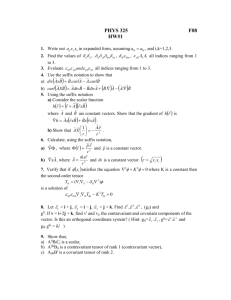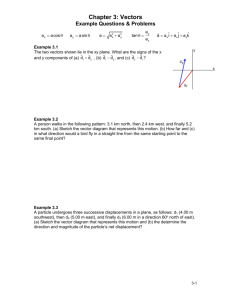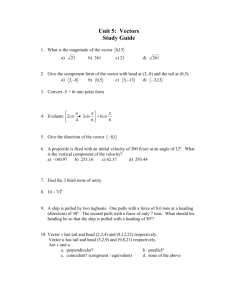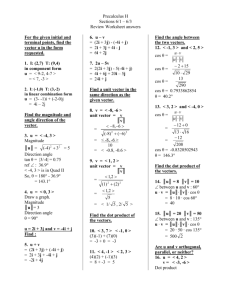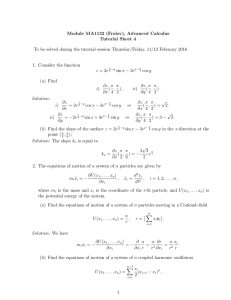Solution to Problem Set 1
advertisement
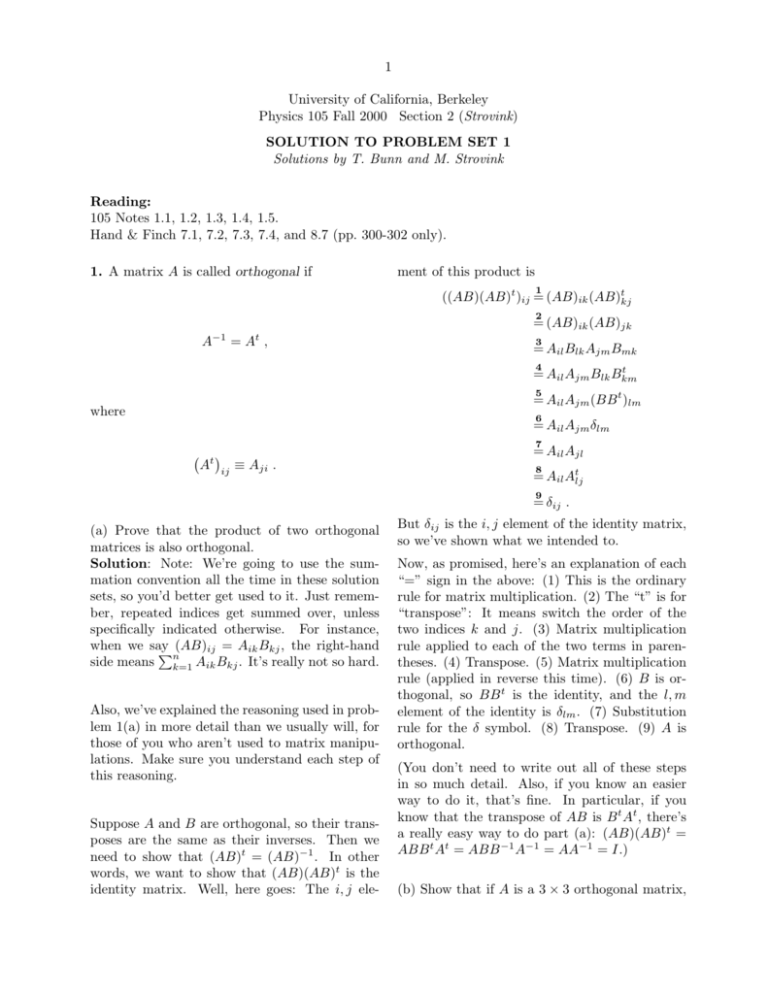
1 University of California, Berkeley Physics 105 Fall 2000 Section 2 (Strovink) SOLUTION TO PROBLEM SET 1 Solutions by T. Bunn and M. Strovink Reading: 105 Notes 1.1, 1.2, 1.3, 1.4, 1.5. Hand & Finch 7.1, 7.2, 7.3, 7.4, and 8.7 (pp. 300-302 only). 1. A matrix A is called orthogonal if ment of this product is 1 ((AB)(AB)t )ij = (AB)ik (AB)tkj 2 A−1 = At , = (AB)ik (AB)jk 3 = Ail Blk Ajm Bmk 4 t = Ail Ajm Blk Bkm 5 = Ail Ajm (BB t )lm where 6 = Ail Ajm δlm t A ij ≡ Aji . 7 = Ail Ajl 8 = Ail Atlj 9 = δij . (a) Prove that the product of two orthogonal matrices is also orthogonal. Solution: Note: We’re going to use the summation convention all the time in these solution sets, so you’d better get used to it. Just remember, repeated indices get summed over, unless specifically indicated otherwise. For instance, when we say n(AB)ij = Aik Bkj , the right-hand side means k=1 Aik Bkj . It’s really not so hard. Also, we’ve explained the reasoning used in problem 1(a) in more detail than we usually will, for those of you who aren’t used to matrix manipulations. Make sure you understand each step of this reasoning. Suppose A and B are orthogonal, so their transposes are the same as their inverses. Then we need to show that (AB)t = (AB)−1 . In other words, we want to show that (AB)(AB)t is the identity matrix. Well, here goes: The i, j ele- But δij is the i, j element of the identity matrix, so we’ve shown what we intended to. Now, as promised, here’s an explanation of each “=” sign in the above: (1) This is the ordinary rule for matrix multiplication. (2) The “t” is for “transpose”: It means switch the order of the two indices k and j. (3) Matrix multiplication rule applied to each of the two terms in parentheses. (4) Transpose. (5) Matrix multiplication rule (applied in reverse this time). (6) B is orthogonal, so BB t is the identity, and the l, m element of the identity is δlm . (7) Substitution rule for the δ symbol. (8) Transpose. (9) A is orthogonal. (You don’t need to write out all of these steps in so much detail. Also, if you know an easier way to do it, that’s fine. In particular, if you know that the transpose of AB is B t At , there’s a really easy way to do part (a): (AB)(AB)t = ABB t At = ABB −1 A−1 = AA−1 = I.) (b) Show that if A is a 3 × 3 orthogonal matrix, 2 its three column vectors are mutually perpendicular and of unit length. Solution: Define Vj to be the j th column vector of A, i.e. (V j )i = Aij . Then Vj · Vk = (V j )i (V k )i = Aij Aik = (At )ki Aij = (At A)kj = Ikj = δkj , where I is the identity matrix. 2. Suppose that a vector x in the space axes is related to a vector x in the body axes by simply replace it by j and get rid of the δij . In this case, the expression Fij δij is the same as Fjj . The index j is repeated, so it’s being summed over. So Fjj means “the sum of all the elements of F that have the same row index and column index.” That sounds the same as “sum of all the diagonal elements”. (b) Prove that Tr(F ) is invariant under any similarity transformation. Solution: We’re being asked to show that if F and F are related by a similarity transformation, then Tr(F ) = Tr(F ). Well, if F and F are similar, then we can write F = AF A−1 for some A. That means that the i, j element of F is Fij = Aik Fkl A−1 lj . So by the trace rule: Tr(F ) = Aik Fkl A−1 lj δij x = Ax , = Aik Fkl A−1 li where A is a transformation matrix. Given a matrix F , find a matrix F , expressed in terms of F and A, such that xt F x = xt F x . F and F are said to be related by a similarity transformation. Solution: If x = Ax, then x = A−1 x . (To see why, multiply both sides of the first equation by A−1 on the left.) Using the fact that the transpose of AB is B t At , we get xt = xt (A−1 )t = xt A. (For the last step, remember that transformation matrices like A are orthogonal.) Now, for any matrix F , xt F x = xt AF A−1 x . (We just substituted for x and xt .) So we can choose the matrix F to be AF A−1 . 3. Define the trace of a matrix F as Tr(F ) = Fij δij , = (A−1 A)lk Fkl = δlk Fkl = Tr(F ) . 4. (a) Use the Levi-Civita density ijk to prove the bac cab rule a × (b × c) = b(a · c) − c(a · b) . Solution: (b × c)k ≡ klm bl cm (a × (b × c))i ≡ ijk aj (b × c)k = ijk aj (klm bl cm ) = ijk klm aj bl cm . Any nonvanishing term must have i, j, l, and m all different from k, but every index must take one of only three values. The possibilities are: where, as usual, summation over repeated in• i = l, j = m: the nonvanishing term (k = i, k = dices is implied. j) has value +1, because ijk = klm are cyclic (a) Show that Tr(F ) is the sum of the diagonal permutations of each other. elements of F . Solution: Remember the substitution rule for • i = m, j = l: the nonvanishing term (k = i, k = δij : If you have an expression containing a δij , j) has value −1, because ijk = klm are not and the i is being summed over, then you can cyclic permutations of each other. 3 Changing these words into an equation in the second line below, (a × (b × c))i = ijk klm aj bl cm = (δil δjm − δim δjl )aj bl cm = aj bi cj − aj ci bj = bi (aj cj ) − ci (aj bj ) = bi (a · c) − ci (a · b) . This is bac cab rule for the ith component. Nothing is special about this component, so the rule is proved in general. (b) Use the bac cab rule to show that a = n̂(a · n̂) + n̂ × (a × n̂) , where n̂ is any unit vector. What is the geometrical significance of each of the two terms in the expansion? Solution: by the bac cab rule, n̂ × (a × n̂) = a(n̂ · n̂) − n̂(n̂ · a) = a − n̂(n̂ · a) a = n̂(a · n̂) + n̂ × (a × n̂) . This expression splits the vector a into two parts, the first of which is parallel to n̂, and the second of which is perpendicular to it. the parallelepiped whose edges they determine. Solution: Using the result of (a), |ijk ui vj wk | = |u × v) · w| = |(u × v)||w|| cos θw | = |u||v|| sin θuv |w|| cos θw | , where θuv is the angle between u and v, and θw is the angle between w and the normal to the plane defined by u and v. The first three factors yield the area of the parallelogram defined by u and v, and the last two factors yield the height of the parallelepiped whose base is this parallelogram. The product of the base area and the height is the volume of the parallelepiped. 6. In a complex vector space, a matrix U is called unitary if U −1 = U † , where † ∗ . U ij ≡ Uji Show than an infinitesimal unitary transformation T (one that is infinitesimally different from the unit matrix) can be written T ≈ I + iH , 5. Consider three vectors u, v, and w. (a) Show that (u × v) · w = ijk ui vj wk , where I is the unit matrix and H is Hermitian, i.e. where, as usual, summation is implied. Solution: In component language, the dot product rule is u · v = ui vi , and the cross product rule is (u × v)k = ijk ui vj . (The only way to see that this rule for cross products is right is to check it explicitly. Let’s see that it works for the z-component: (u × v)3 = 123 u1 v2 + 213 u2 v1 = u1 v2 − u2 v1 , which is right.) H = H† . So (u × v) · w = (u × v)k wk = ijk ui vj wk . (b) If u, v, and w emanate from a common point, show that |ijk ui vj wk | is the volume of Solution: T = I + iH T † = I † + (iH)† = I + H † i† = I + H † (−i) = I − iH † , where in the second line we used the fact that, as for the transpose, (AB)† = B † A† . Enforcing 4 to the x1 , x2 , and x3 (space) axes, respectively. Solution: It is somewhat easier to find Λt such that xi = Λtij xj , as is the case for the Euler rotation (105 lecture notes 1.5). We accomplish the transformation from the primed to the unprimed coordinates in three steps: the unitarity condition on T , T −1 = T † I = T −1 T = T †T = (I − iH † )(I + iH) = I + i(H − H † ) + O(H 2 ) ≈ I + i(H − H † ) 0 ≈ i(H − H † ) (i) Rotate the x1 and x2 axes about the x3 axis so that the new “1” direction (call it x1 ) is along the given unit vector n̂ . Call the rotation matrix which accomplishes this A. (ii) Rotate the x2 and x3 axes counterclockwise about the x1 (or n̂ ) axis by the given angle ξ. Call the matrix which accomplishes this B. 7. Show that v, p, and E (velocity, momen(iii) Reverse the rotation (i). This is necessary so tum, and electric field) are ordinary (“polar”) vectors, while ω, L, and B (angular velocity, an- that, for example, if ξ is zero there will have gular momentum, and magnetic field) are pseudo been no net change. Call the matrix which accomplishes this C. (“axial”) vectors. Solution: Obviously r = (x1 , x2 , x3 ), the poWe will then have Λt = CBA, or Λ = At B t C t . sition vector, changes sign under parity inverWhat are the elements of these rotation masion P, which transforms (x1 → −x1 , x2 → trices? Remembering that we are dealing with −x2 , x3 → −x3 ). Therefore r is a polar vecpassive rotations (the axes get rotated, not the tor. Since v ≡ dr/dt and p = mv, v and p are vectors), rotation A is also polar vectors. So is the force F = dp/dt. The force on a test charge q is F = qE, so E cos φ sin φ 0 must also be a polar vector. A = − sin φ cos φ 0 , = However (see 105 lecture notes eq. (1.7)), vtang 0 0 1 ω × r implies that ω cannot change sign under P, inasmuch as vtang and r both do change sign. where φ is the angle whose cosine is n and 1 Therefore ω is an axial vector. Similarly, L = r× whose sine is n . (For getting A right, the only 2 p is an axial vector because both r and p change tricky part is to figure out where the minus sign sign under P. Likewise, the magnetic part of the goes. It is straightforward to do this by conforce F = qv×B requires B to be an axial vector sidering the effect of operating A on n̂ itself: because F and v both change sign under P. the result should be, and is, entirely in the “1” H† ≈ H . 8. Find the transformation matrix Λ, such that xi = Λij xj , which describes the following (passive) transformation: relative to the space (primed) axes, the body (unprimed) axes are rotated counterclockwise by an angle ξ about a unit vector n̂ which has direction cosines n1 , n2 , and 0 with respect (n1 )2 + (n2 )2 cos ξ Λ = n1 n2 (1 − cos ξ) −n2 sin ξ direction.) Similarly, rotation matrix B is 1 0 B = 0 cos ξ 0 − sin ξ 0 sin ξ . cos ξ C is merely the inverse of A: C = At . Then Λ = At B t A. Substituting cos φ = n1 , sin φ = n2 and multiplying the matrices, n1 n2 (1 − cos ξ) (n2 )2 + (n1 )2 cos ξ n1 sin ξ n2 sin ξ −n1 sin ξ . cos ξ

